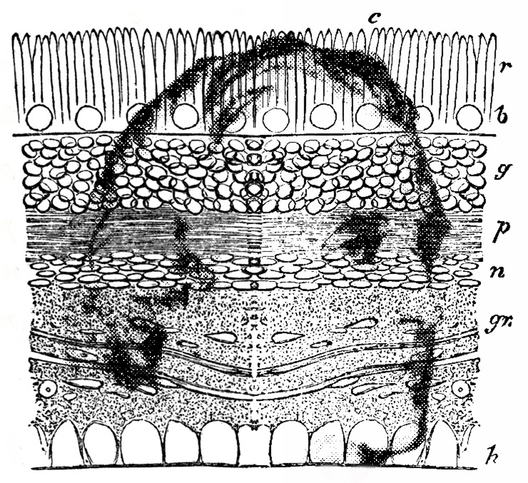William Bowman1816–1892
The retina proved to be an ideal structure for examination under the new achromatic microscopes that became available after the 1820s. Johannes Müller described seeing “rod-shaped” bodies in the retina, but their relationship to the optic nerve fibres remained uncertain. The possibility of more complex connections within the layers of the retina were alluded to by Müller, but the receptive elements were considered to be ‘rod-shaped’. Within a few years, cones as well as rods had been isolated and structure was related to function, largely due to the microscopical studies of Bowman, Kölliker, and Schultze. In 1849, Bowman provided a diagram of the retina (in which his portrait is embedded), which distinguished between what he called rods and bulbs. He described the constituents of the retina in the following way: “Now, the retina contains in itself all the structural elements which are found in other parts of the system, except nerve-tubules, which are not present in the human retina, nor in the retina of the higher animals, but only in the optic nerve; and it moreover contains, besides these, other structural elements not elsewhere met with, but peculiar to this part, and which we are therefore led to suspect may be in some way or other subservient to the proper action of the retina as a recipient of the vibratory impressions of light…. The elements peculiar to the retina are… of two kinds – Columnar particles, or rods, arranged vertically in a single series; and Bulbous particles, interspersed at regular intervals among the former.” Bowman drew attention to the disagreements about the interpretations of the terminal structures of the retina, and to the difficulties of obtaining good specimens for microscopical study. The texture of the retina was quite different around the yellow spot: “the grey fibres do not pass over it in a direct course from the optic nerve to the side of the retina beyond the spot, but take a circuitous course, so as to avoid the spot, and only that small number which properly belong to it, and terminate in it”. Bowman did describe differences in the numbers of rods and bulbs in different species, but no generalization was drawn from this. He described the bulbs as “globular or egg-shaped, and sometimes to have a small blunt spur upon them, turned towards the choroid”, but Hannover’s (1844) ‘cônes’ was the name for them that was generally adopted. In German they were called Zapfen, and this is the term used by Helmholtz.
